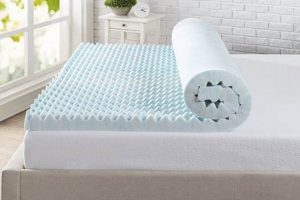A sleeping surface crafted primarily from the sap of rubber trees and designed for optimal comfort and support represents a significant investment in restorative rest. These products are available in various firmness levels and construction methods, each impacting the overall feel and suitability for different sleep preferences. For example, a firmer model may benefit individuals who sleep on their back or stomach, while a softer one might be preferable for side sleepers seeking pressure relief.
The selection of such a sleep system provides potential advantages including enhanced spinal alignment, minimized motion transfer, and increased breathability, leading to a cooler and more comfortable sleep environment. Historically, rubber-based bedding has evolved from its initial development in the early 20th century, incorporating advancements in processing techniques to enhance durability and performance. Its inherent hypoallergenic and antimicrobial properties contribute to a healthier sleep environment, particularly beneficial for individuals with allergies or sensitivities.
The following discussion will delve into the key factors to consider when evaluating these premium sleep solutions, including material types, construction methods, certifications, and overall value proposition. Understanding these aspects is crucial for making an informed decision that aligns with individual needs and preferences.
Selecting the Optimal Latex Mattress
Choosing a suitable latex mattress necessitates careful consideration of several key factors. The following tips provide guidance in navigating the selection process to ensure optimal comfort and long-term satisfaction.
Tip 1: Determine Material Type: Distinguish between Dunlop and Talalay latex. Dunlop is denser and firmer, often preferred for core support. Talalay is lighter and softer, typically used in comfort layers for enhanced pressure relief.
Tip 2: Evaluate ILD Ratings: Indentation Load Deflection (ILD) ratings indicate firmness. Lower ILD numbers signify a softer feel, while higher numbers denote a firmer feel. Align the ILD rating with preferred sleep position and body weight.
Tip 3: Consider Mattress Construction: Pay attention to the layering of latex and other materials. A mattress with multiple layers of varying densities can provide a more customized feel and improved support.
Tip 4: Check for Certifications: Look for certifications such as GOLS (Global Organic Latex Standard) or Oeko-Tex Standard 100. These certifications ensure that the mattress meets stringent environmental and safety standards.
Tip 5: Assess Motion Isolation: Latex inherently offers good motion isolation. If sharing the bed, consider the mattress’s ability to minimize motion transfer for undisturbed sleep.
Tip 6: Evaluate Thickness: The thickness of a latex mattress influences its support and durability. A thicker mattress may offer better support and longevity, especially for heavier individuals.
Tip 7: Understand Warranty and Return Policies: Review the warranty and return policies before purchasing. A comprehensive warranty and a generous return window provide reassurance and protection against potential defects or dissatisfaction.
Careful adherence to these guidelines will increase the likelihood of selecting a latex mattress that provides optimal comfort, support, and durability. The long-term benefits of a well-chosen sleep surface include improved sleep quality, reduced pain, and enhanced overall well-being.
The subsequent sections will explore additional aspects of latex mattress care and maintenance, ensuring its longevity and sustained performance.
1. Material Density
Material density is a critical determinant of latex mattress performance and longevity. It directly influences support, durability, and overall sleeping experience. A thorough understanding of density is essential when evaluating a latex mattress.
- Support and Firmness
Higher density latex generally offers greater support and a firmer feel. This is due to the increased amount of material packed into a given volume. Conversely, lower density latex tends to be softer and provide less resistance. Selecting an appropriate density is crucial for spinal alignment and pressure relief, particularly for individuals with specific sleep preferences or physical conditions.
- Durability and Longevity
Density directly correlates with the lifespan of a latex mattress. High-density latex is more resilient and resistant to compression, maintaining its shape and support over extended periods. Lower density latex is more prone to sagging and indentation, leading to a shorter lifespan. The cost-effectiveness of a mattress is directly related to its ability to maintain its structural integrity over time, making density a key consideration.
- Responsiveness and Bounce
Density affects the responsiveness or “bounce” of a latex mattress. Higher density latex often exhibits a more pronounced bounce, providing a responsive and supportive feel. Lower density latex may feel less responsive and more conforming. The desired level of responsiveness is subjective and depends on individual preferences for sleep feel.
- Weight and Handling
It’s important to note that high-density latex mattresses tend to be heavier, making them more difficult to move and handle. This factor should be considered, especially for individuals who anticipate frequent relocation or repositioning of the mattress. Logistics and ease of use are impacted by the overall weight and density of the mattress construction.
Therefore, material density is a significant aspect in determining suitability. Higher density may be preferable for those seeking greater support and durability, while lower density may suit those prioritizing a softer, more conforming feel. Evaluating these trade-offs is essential in selecting a latex mattress that aligns with individual needs and expectations.
2. Construction Quality
Construction quality is paramount in determining the performance and longevity of a latex mattress. It encompasses the materials used, the methods of assembly, and the attention to detail applied during the manufacturing process. These factors collectively influence the mattress’s support, comfort, and durability. A high-quality construction contributes significantly to the overall value and satisfaction derived from a latex mattress purchase.
- Layering and Adhesion
The arrangement and bonding of latex layers, along with other materials such as organic cotton or wool, directly impact the overall feel and performance of the mattress. Poorly adhered layers can lead to shifting, uneven support, and premature wear. Quality construction involves secure and
durable adhesion methods that maintain the integrity of the mattress layers over time. For instance, natural adhesives or advanced lamination techniques demonstrate a commitment to quality and contribute to a more stable and comfortable sleep surface. - Stitching and Cover Materials
The quality of stitching on the mattress cover and the properties of the cover material itself are indicators of overall construction quality. Weak or uneven stitching can result in tearing or unraveling, compromising the mattress’s structure. High-quality cover materials, such as organic cotton or breathable fabrics, enhance comfort and contribute to temperature regulation. Reinforced seams and durable zippers are further signs of meticulous construction, ensuring the mattress’s longevity and visual appeal.
- Core Support System
The core of a latex mattress, whether composed of a solid latex layer or a combination of materials, provides the foundation for support and pressure relief. A well-constructed core maintains proper spinal alignment and prevents sagging. Features such as zoned support systems, where different areas of the mattress offer varying levels of firmness, are indicative of advanced construction techniques aimed at optimizing comfort and orthopedic support.
- Edge Support Reinforcement
Edge support is critical for maximizing the usable sleep surface and preventing the sensation of rolling off the mattress. Reinforced edges, constructed with denser latex or other supportive materials, enhance stability and prevent edge collapse over time. Mattresses with inadequate edge support may exhibit premature wear and reduced comfort, particularly for individuals who sleep near the edge of the bed.
In conclusion, a close examination of construction quality reveals the underlying factors that differentiate a superior latex mattress from a substandard one. By prioritizing features such as robust layering, durable stitching, a supportive core, and reinforced edges, consumers can make informed decisions that lead to lasting comfort and value. These elements work in concert to ensure the mattress delivers optimal support, minimizes motion transfer, and maintains its integrity for years to come.
3. Firmness Level
The term “best latex mattress” is incomplete without considering the crucial role of firmness level. Firmness, often quantified using an Indentation Load Deflection (ILD) rating, dictates the feel of the mattress, ranging from plush to extra-firm. This parameter is not an arbitrary preference but a direct determinant of spinal alignment and pressure point relief. For example, a side sleeper typically benefits from a softer mattress to cushion the shoulder and hip, promoting a neutral spine. Conversely, an individual who sleeps on their back often requires a firmer surface to prevent excessive sinkage and maintain lumbar support. Therefore, the “best” designation is contingent on the user’s specific needs and the mattress’s ability to address those needs through an appropriate firmness profile.
The relationship between firmness and optimal sleep quality is supported by clinical evidence. Studies indicate that a mattress that conforms to the natural curves of the spine reduces pressure on intervertebral discs and associated nerve structures. This, in turn, minimizes pain and discomfort, leading to more restful sleep. For instance, a medium-firm latex mattress may be ideal for individuals with lower back pain, providing a balance of support and cushioning. Furthermore, the appropriate firmness level can enhance blood circulation and reduce tossing and turning during the night. Understanding this connection allows consumers to make informed decisions based on their individual physiology and sleep habits.
The assessment of firmness level presents a challenge due to subjective perceptions and variations in manufacturing standards. ILD ratings offer a standardized measure, but it is essential to consider personal factors such as body weight and sleep position. The practical significance of understanding firmness lies in its ability to translate scientific findings into personalized comfort. By considering these factors, consumers can move beyond generalized claims and identify a latex mattress that truly promotes restorative sleep and supports long-term musculoskeletal health. The “best latex mattress”, therefore, is an individualized determination that prioritizes alignment between mattress firmness and user needs.
4. Certifications
Certifications serve as crucial indicators of a latex mattress’s composition, manufacturing process, and adherence to established environmental and health standards. They provide consumers with a degree of assurance regarding the product’s quality and ethical sourcing, factors frequently considered when seeking the “best latex mattress”. These certifications offer objective verification of claims made by manufacturers, aiding informed decision-making.
- Global Organic Latex Standard (GOLS)
GOLS certification ensures that the latex used in a mattress originates from organic rubber tree plantations and is processed according to stringent environmental and social criteria. For instance, a GOLS-certified mattress guarantees that the latex component contains a minimum of 95% certified organic raw materials. This certification provides assurance that the product meets rigorous standards for organic content, chemical emissions, and fair labor practices, appealing to consumers prioritizing environmental sustainability.
- Oeko-Tex Standard 100
Oeko-Tex Standard 100 certification verifies that a mattress has been tested for harmful substances and meets stringent limits for chemical emissions. This certification evaluates the product’s components, including fabrics, threads, and fillings, ensuring they are free from potentially harmful chemicals like formaldehyde, pesticides, and heavy metals. The presence of this certification indicates a commitment to consumer health and safety, enhancing the mattress’s appeal as a healthy sleep surface. For example, Oeko-Tex certification on a latex mattress suggests minimal exposure to allergenic or carcinogenic substances.
- eco-INSTITUT
eco-INSTITUT certification focuses on indoor air quality and the emission of volatile organic compounds (VOCs) from a product. A latex mattress with eco-INSTITUT certification has undergone testing to ensure it meets strict emission limits, contributing to a healthier indoor environment. This certification is particularly relevant for individuals sensitive to chemical odors or those seeking products with minimal off-gassing. For example, eco-INSTITUT certification verifies low VOC emissions from the latex and other components, promoting better air quality in the bedroom.
The presence of these certifications provides valuable insights into the quality and composition of a latex mattress, facilitating a more informed selection process. While certifications do not guarantee a “best” mattress for every individual, they offer objective criteria for evaluating environmental responsibility, health safety, and product quality. By prioritizing mattresses with reputable certifications, consumers can increase the likelihood of selecting a product that aligns with their values and contributes to a healthier sleep environment.
5. Longevity
Longevity represents a critical factor in determining the overall value proposition of a latex mattress. While initial comfort and support are paramount, the long-term performance and durability of the mattress directly impact its cost-effectiveness and sustainability. A mattress that requires frequent replacement negates any initial cost savings, making longevity a primary consideration for informed consumers.
- Material Degradation Resistance
The inherent properties of latex, particularly its resistance to degradation from factors such as oxidation and compression, contribute significantly to its lifespan. High-quality latex demonstrates superior resistance to breakdown, maintaining its support and shape over extended use. For instance, a well-maintained, high-density natural latex mattress can retain its structural integrity for upwards of 10-15 years, compared to traditional mattresses that may exhibit sagging and diminished support within a shorter timeframe. This prolonged lifespan translates into reduced replacement costs and environmental impact.
- Construction Integrity Preservation
The manner in which a latex mattress is constructed plays a vital role in its long-term performance. Robust layering, secure adhesion, and durable cover materials contribute to the mattress’s ability to withstand daily use and resist wear and tear. A poorly constructed mattress, regardless of the quality of the latex itself, is prone to premature failure. Examples include seam separation, material bunching, and uneven settling, all of which diminish comfort and reduce the usable lifespan of the product. Effective construction techniques safeguard against these issues, preserving the mattress’s intended functionality and extending its service life.
- Weight Load Capacity Maintenance
A mattress’s ability to consistently support a specified weight load over an extended period is a crucial aspect of longevity. High-quality latex mattresses are designed to distribute weight evenly, preventing localized compression and maintaining uniform support across the entire surface. This is particularly important for individuals with higher body weights or those who share a bed. A mattress that fails to maintain its weight-bearing capacity will develop sagging and unevenness, leading to discomfort and potential musculoskeletal issues. Robust design and high-density materials ensure long-term weight load capacity, contributing significantly to the mattress’s lifespan.
- Resistance to Microbial Growth
The inherent antimicrobial properties of natural latex contribute to its longevity by inhibiting the growth of bacteria, mold, and mildew. This resistance not only promotes a healthier sleep environment but also prevents the degradation of the mattress materials caused by microbial activity. Traditional mattresses, often lacking these properties, can accumulate allergens and microorganisms over time, leading to material breakdown and reduced lifespan. The inherent resistance of latex to microbial growth helps to maintain its structural integrity and freshness, extending its usable life and reducing the need for frequent cleaning or replacement.
The facets of material degradation resistance, construction integrity preservation, weight load capacity maintenance, and microbial resistance collectively underscore the critical role of longevity in evaluating a latex mattress. Mattresses that prioritize these aspects offer enhanced value, reduced environmental impact, and sustained comfort over an extended period. As such, longevity represents a pivotal determinant in defining what constitutes the “best latex mattress” for discerning consumers.
Frequently Asked Questions
The following section addresses common inquiries regarding latex mattresses, providing clarity and guidance for potential purchasers.
Question 1: What distinguishes natural latex from synthetic latex in mattresses?
Natural latex originates from the sap of rubber trees, exhibiting superior durability, breathability, and conforming support. Synthetic latex, derived from petrochemicals, generally offers a lower cost but may lack the performance characteristics and longevity of its natural counterpart. Distinguishing between these materials is crucial when evaluating a mattresss overall value.
Question 2: How does the firmness of a latex mattress impact sleep quality?
Mattress firmness significantly influences spinal alignment and pressure point relief. A firmness level aligned with an individual’s sleep position and body weight promotes optimal support and comfort. Misalignment between firmness and individual needs can result in discomfort and disrupted sleep patterns.
Question 3: What certifications should consumers seek when purchasing a latex mattress?
Certifications such as GOLS (Global Organic Latex Standard) and Oeko-Tex Standard 100 provide assurance regarding the mattress’s organic composition and the absence of harmful substances. These certifications offer objective verification of claims made by manufacturers, aiding informed decision-making.
Question 4: What is the expected lifespan of a high-quality latex mattress?
A well-maintained, high-density natural latex mattress can typically retain its structural integrity and support characteristics for 10-15 years. Factors such as material quality, construction techniques, and usage patterns influence the actual lifespan of the mattress.
Question 5: How does latex mattress construction impact motion isolation?
Latex mattresses generally exhibit good motion isolation properties, minimizing the transfer of movement across the sleep surface. This attribute is particularly beneficial for individuals sharing a bed, as it reduces disturbances caused by a partner’s movements. Denser latex and strategic layering can further enhance motion isolation.
Question 6: What considerations are relevant for individuals with allergies when selecting a latex mattress?
Natural latex possesses inherent hypoallergenic properties, making it a suitable choice for allergy sufferers. However, individuals with known latex allergies should exercise caution and consult with a medical professional before using a latex mattress. Selecting mattresses with certifications that verify the absence of allergenic substances minimizes potential risks.
In summary, informed decisions regarding latex mattress purchases require careful consideration of material composition, firmness level, certifications, and construction techniques. Addressing these factors contributes to selecting a product that aligns with individual needs and preferences.
The subsequent section will explore practical tips for maintaining a latex mattress, ensuring its longevity and performance.
Conclusion
The pursuit of the “best latex mattress” necessitates careful evaluation of factors spanning material composition to construction integrity. Density influences support, firmness dictates spinal alignment, and certifications validate product safety and ethical sourcing. Longevity, ultimately, determines the mattress’s long-term value. A comprehensive understanding of these elements enables consumers to navigate the market effectively.
In light of the considerations outlined, the selection of a latex mattress remains a personalized decision, demanding careful self-assessment and informed comparison. The enduring benefits of a well-chosen sleep surface extend beyond immediate comfort, influencing long-term health and well-being. Prospective buyers are enco
uraged to prioritize thorough research and thoughtful deliberation, ensuring a sound investment in restorative sleep.


![Top-Rated Best Guest Mattress [Guide] for Comfortable Sleep Organic & Natural Mattress Buyer’s Guide: Non-Toxic Sleep Solutions Top-Rated Best Guest Mattress [Guide] for Comfortable Sleep | Organic & Natural Mattress Buyer’s Guide: Non-Toxic Sleep Solutions](https://mattressworldpa.com/wp-content/uploads/2025/07/th-7619-300x200.jpg)

![Top-Rated: Best Mattress for Teenager [Sleep Better!] Organic & Natural Mattress Buyer’s Guide: Non-Toxic Sleep Solutions Top-Rated: Best Mattress for Teenager [Sleep Better!] | Organic & Natural Mattress Buyer’s Guide: Non-Toxic Sleep Solutions](https://mattressworldpa.com/wp-content/uploads/2025/07/th-7617-300x200.jpg)


